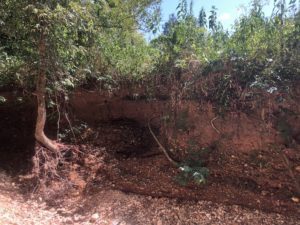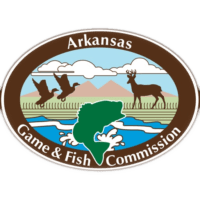Beaver Lake has a variety of habitats, including 450 miles of shoreline. Shoreline habitat varies from shallow sloping mud flats, moderately sloping gravel and cobble banks, to sheer vertical limestone and sandstone cliffs with large rockslides. Historically, standing timber was abundant in some coves, but is now deteriorating as the lake ages.
The fertility of Beaver Lake varies from being extremely fertile in the upper reaches of the tributary arms to being relatively infertile in the lower areas around the dam. This fertility gradient is a function of the high retention time (1.5 year’s average) of water in the reservoir working in combination with varying inflows of nutrients and sediment into the reservoir.
Nutrient and sediment inflows can vary greatly depending on rainfall amounts and agricultural and urban practices in the watershed. The Beaver Lake watershed is 1,192 square miles, and includes portions of Benton, Carroll, Washington, and Madison counties and 17 incorporated municipalities or villages (see Figure 1 and 2). Major nutrient and sediment sources include nonpoint sources such as erosion of stream banks and major county roads, fertilized pasturelands, poultry and swine farms and urban storm water runoff.
Stream Channel and Riparian Stabilization Project
 According to the Beaver Lake Watershed Protection Strategy (Strategy), future annual sediment loading is estimated to increase 21 percent or almost 50,000 tons per year. Without additional protective measures, stream channel erosion is estimated to contribute most (approximately 60 percent) of the sediment load to Beaver Lake. While the decrease in areas categorized as agriculture, pasture, and forest will reduce sediment loading by around 18,400 tons/year from those sources, channel erosion and land developed as low density residential tracts are estimated to increase sediment contributions by approximately 28,850 and 36,700 tons/year, respectively. By 2055, the total phosphorus in the lake is expected to increase by approximately 24,000 pounds per year. As with sediment, the Beaver Lake and War Eagle Creek subwatersheds are predicted to be the largest sources of phosphorus to the lake. The War Eagle Creek subwatershed is predicted to deliver the largest nitrogen load under both existing and future scenarios (See Figures 3 and 4). War Eagle Creek is also listed by the Arkansas Division of Environmental Quality as an impaired stream due to increased siltation and nutrients.
According to the Beaver Lake Watershed Protection Strategy (Strategy), future annual sediment loading is estimated to increase 21 percent or almost 50,000 tons per year. Without additional protective measures, stream channel erosion is estimated to contribute most (approximately 60 percent) of the sediment load to Beaver Lake. While the decrease in areas categorized as agriculture, pasture, and forest will reduce sediment loading by around 18,400 tons/year from those sources, channel erosion and land developed as low density residential tracts are estimated to increase sediment contributions by approximately 28,850 and 36,700 tons/year, respectively. By 2055, the total phosphorus in the lake is expected to increase by approximately 24,000 pounds per year. As with sediment, the Beaver Lake and War Eagle Creek subwatersheds are predicted to be the largest sources of phosphorus to the lake. The War Eagle Creek subwatershed is predicted to deliver the largest nitrogen load under both existing and future scenarios (See Figures 3 and 4). War Eagle Creek is also listed by the Arkansas Division of Environmental Quality as an impaired stream due to increased siltation and nutrients.
War Eagle Creek has been sampled over the years and supports an average population of Largemouth Bass, Smallmouth Bass and Spotted Bass (Quinn et al 2010). However, major flooding in the creek, which led to increased siltation, was linked to a reduction in catch rates of black bass in 2014. A reduced creel limit was put in place in 2014 (creel limit reduced from 6 per day to 2 per day on black bass).
Invasive Red Cedar Tree Habitat Project
Thousands of standing trees that were in the lake during impoundment have broken down and are no longer available habitat for aquatic species. This loss of fish habitat is occurring in large reservoirs all over the United States (Miranda 2017) and habitat enhancement projects are very important for fish species. Peer projects to reference include a large-scale fish habitat project on Table Rock Lake, located just downstream of Beaver Lake, which placed over 2,000 new habitat sites and greatly improved fish biomass, which increased angler satisfaction and catch rates after the project (Allen et al. 2014). The project was completed in 5 years and over $4 million dollars were contributed towards improvements for fish habitat in the lake. Surveys conducted from the Table Rock fish habitat enhancement projects showed these to be very popular with the angler communities. A professional angler indicated that the project made it easier for fisherman to find and catch fish (Norris 2016). This proposed Beaver Lake project will be just as important and popular with anglers, hunters, wildlife enthusiasts, and nature observers.


